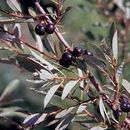pms
nòm ant ël fil


Prunus pumila, commonly called sand cherry, is a North American species of cherry in the rose family. It is widespread in eastern and central Canada from New Brunswick west to Saskatchewan and the northern United States from Maine to Montana, south as far as Colorado, Kansas, Indiana, and Virginia, with a few isolated populations in Tennessee and Utah.[1][3] It grows in sandy locations such as shorelines and dunes.[4]
Prunus pumila is a deciduous shrub that grows to 0.61–1.83 metres (2–6 feet) tall depending on the variety.[5] It forms dense clonal colonies by sprouts from the root system. The leaves are leathery, 4–7 centimetres (1+5⁄8–2+3⁄4 inches) long, with a serrated margin. The flowers are 15–25 millimetres (9⁄16–1 in) in diameter with five white petals and 25–30 stamens. They are produced in small clusters of two to four. The fruit is a small cherry 13–15 mm (1⁄2–9⁄16 in) in diameter, ripening to dark purple in early summer.[6][7][8]
Prunus pumila, commonly called sand cherry, is a North American species of cherry in the rose family. It is widespread in eastern and central Canada from New Brunswick west to Saskatchewan and the northern United States from Maine to Montana, south as far as Colorado, Kansas, Indiana, and Virginia, with a few isolated populations in Tennessee and Utah. It grows in sandy locations such as shorelines and dunes.
Prunus pumila is a deciduous shrub that grows to 0.61–1.83 metres (2–6 feet) tall depending on the variety. It forms dense clonal colonies by sprouts from the root system. The leaves are leathery, 4–7 centimetres (1+5⁄8–2+3⁄4 inches) long, with a serrated margin. The flowers are 15–25 millimetres (9⁄16–1 in) in diameter with five white petals and 25–30 stamens. They are produced in small clusters of two to four. The fruit is a small cherry 13–15 mm (1⁄2–9⁄16 in) in diameter, ripening to dark purple in early summer.
Varieties Prunus pumila var. besseyi (Bailey) Gleason, western sand cherry (also called Rocky Mountain cherry) – Saskatchewan, Manitoba, western Ontario, south to Colorado and Kansas Prunus pumila var. depressa (Pursh) Gleason, eastern sand cherry – Ontario, Québec, New Brunswick south to Pennsylvania Prunus pumila var. pumila, Great Lakes sand cherry – shores of Great Lakes Prunus pumila var. susquehanae (hort. ex Willd.) Jaeger, Susquehana sand cherry – from Manitoba east to Maine, south to Tennessee Prunus × cistena (purple leaf sand cherry) is a hybrid of Prunus cerasifera (cherry plum) and P. pumila. It was developed by Niels Ebbesen Hansen of South Dakota State University in 1910. They grow to be about 2.1 m (7 ft) tall and can live for up to 20 years.